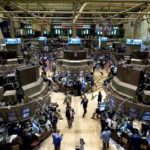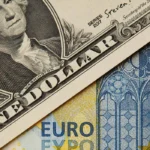The euro remained lower against the US dollar on trading Tuesday, as market players were cautious ahead of European Central Banks interest rate decision and President Mario Draghis statement on Thursday.
EUR/USD slipped to a session low at 1.3482 at 8:55 GMT, after which consolidation followed at 1.3489, losing 0.20% for the day. Support was likely to be received at November 4th low and also a 1.5-month low, 1.3441, while resistance was to be encountered at October 15th high, 1.3570.
Having fallen to six-week lows on Monday, the euro managed to recover, supported by a report by Markit Economics yesterday, according to which the final value of the index, gauging manufacturing activity in the Euro zone for October matched the preliminary reading at 51.3 and also improved in comparison with September, when the index came in at 51.1.
However, the common currency will likely continue experiencing pressure ahead of European Central Banks (ECB) decision on interest rates. The ECB will conduct a meeting on policy on November 7th, with 65 out of 68 economists, participated in a survey by Bloomberg News, projecting that banks policymakers will maintain the benchmark rate at the current record low level of 0.5%. Bank of America Corp., UBS AG and Royal Bank of Scotland Group Plc, however, predict that a rate cut may occur. Such a forecast is probably based on the fact that the preliminary annual consumer price index in the Euro zone, evaluated in consonance with the harmonized methodology, climbed 0.7% in October, marking the slowest pace since November 2009, after in September the index rose 1.1%.
The ECB has said there was a “subdued outlook” for price growth in the common currency bloc, while the October data marked the ninth consecutive month, during which the inflation rate has been below central bank’s 2% objective, a level considered as providing price stability.
The meeting will be followed by a statement by ECB President Mario Draghi, during which, usually, high volatility is observed. “We expect Draghi to be fairly dovish, and I think people are already beginning to position for that, either by cutting euro longs or initiating euro shorts,” said Hamish Pepper, a Singapore-based currency strategist at Barclays Plc., cited by Bloomberg.
Additionally, today it became clear that the number of unemployed people in Spain increased more than projected in October, as the majority of hired people during the summer touristic period were now without a job. According to the Department of Labor in the country, the number of the jobless rose by 87 028 in October instead of 82 500 to reach over 4.8 million, after a month ago unemployed people were 25 572 more. September and October, traditionally, are months during which unemployment increases, as the summer temporary employment drops. However, this increased unemployment came amid signs that nations economy was recovering. Preliminary data showed that Spanish GDP figure rose 0.1% during the third quarter of the year, after two years of recession. In annual terms, the number of unemployed people diminished by 22 138 during October, or the first annual drop since May 2007.
Meanwhile, comments made by Federal Reserve Bank officials signaled that the central bank will probably maintain the current monthly pace of its stimulus for some time.
“Monetary policy is likely to need to remain accommodative for some time so that we can achieve full employment within a reasonable forecast horizon,” Boston Fed President Eric Rosengren, who votes on monetary policy this year, said in a speech in Boston on Monday. “The economy remains challenged.”
Richmond Fed President Jeffrey Lacker is to take a statement on the labor market in Charlotte, North Carolina on trading Tuesday. Earlier in November he said that the probability of another recession was probably higher than estimated.
Elsewhere, the euro was falling against the British pound, as EUR/GBP cross lost 0.64% on a daily basis to trade at 0.8411. EUR/JPY pair was also losing ground today, down 0.48% to trade at 132.64.





